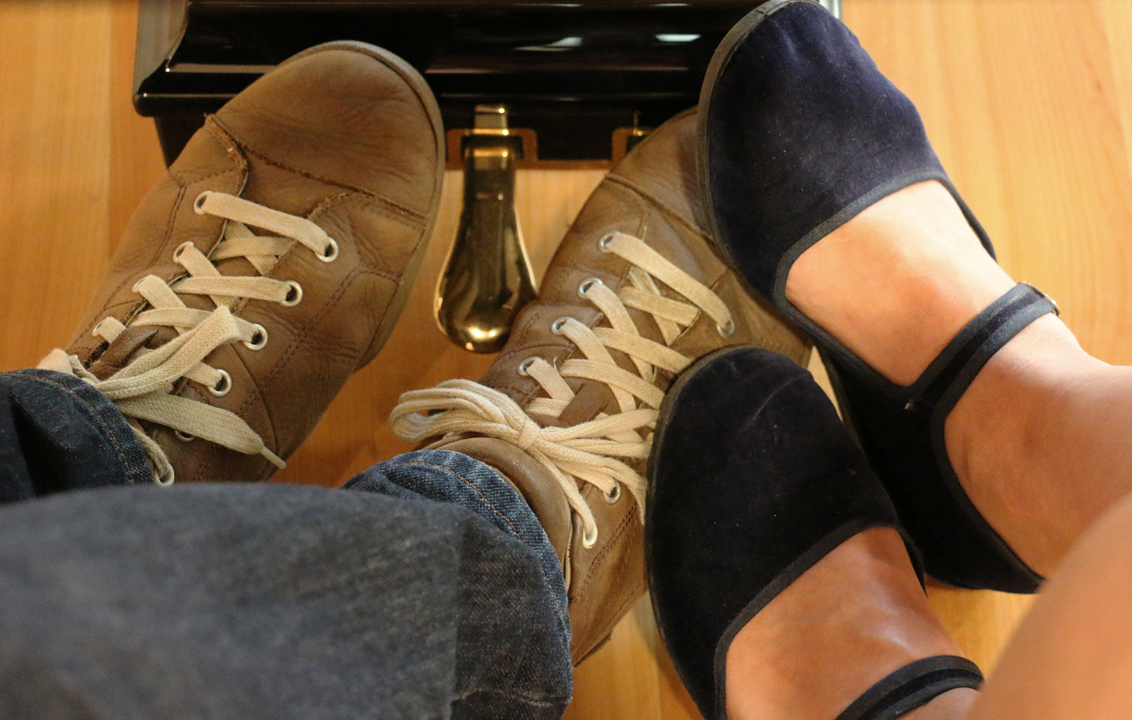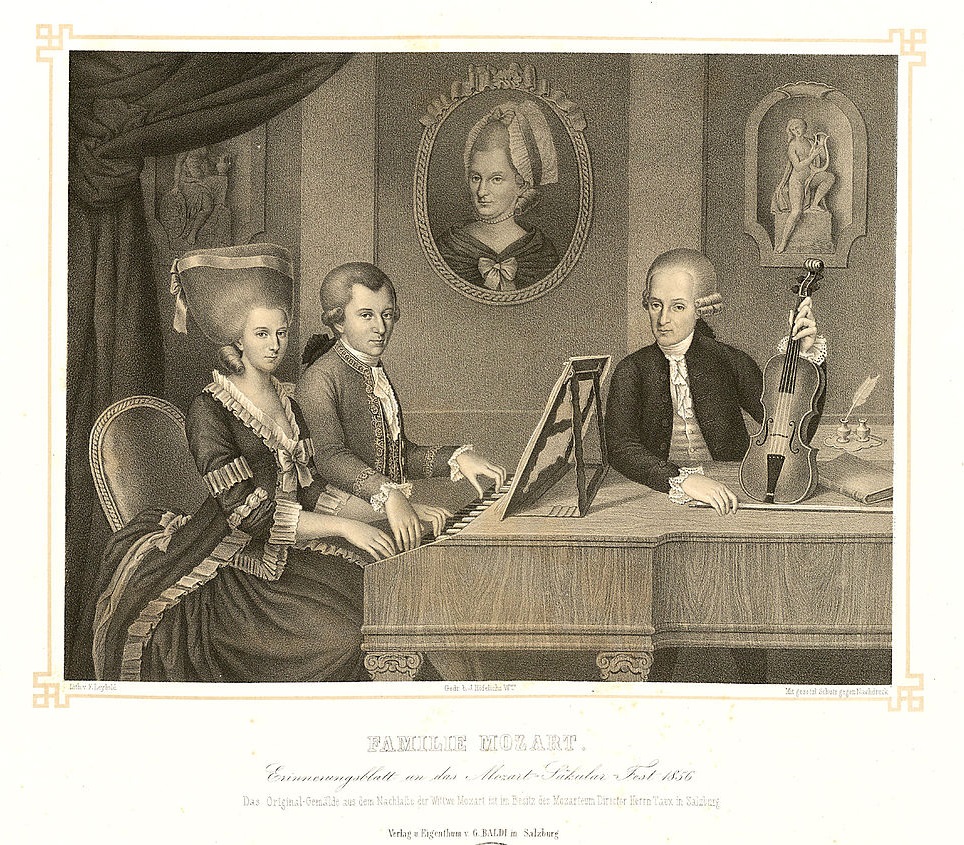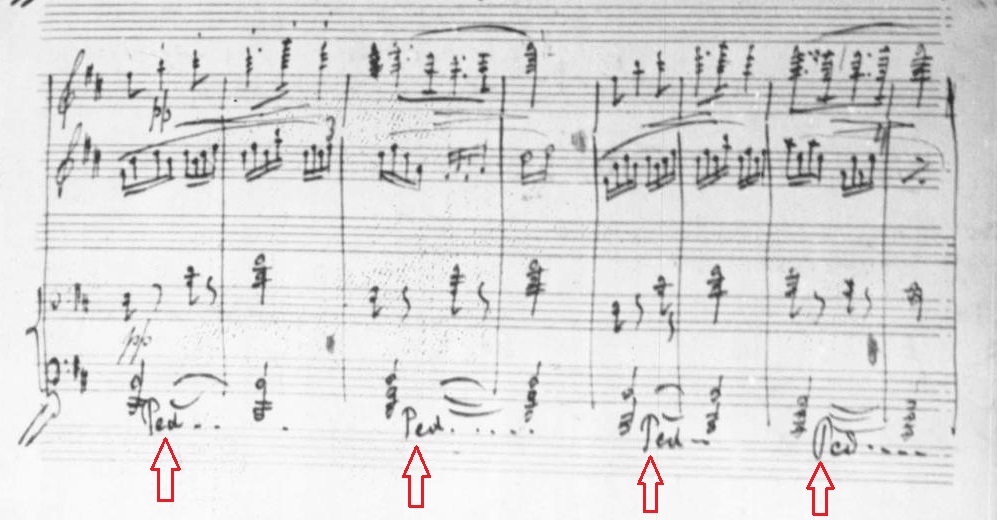 Nowadays we automatically associate music for piano duet with the 19th century. It is the very definition of the domestic-music genre. Many in the Biedermeier world could play piano and really make quite illustrious music in a duet with relatively little effort – that is to say with modest technical ability. It is therefore precisely in piano lessons that piano-duet playing is much and eagerly practised today. The teacher mostly plays the Secondo part (and thus ensures an orchestral foundation), while the student is taxed with the more easily managed melody-carrying Primo part (we need only think of works by the inevitable Anton Diabelli). Feeling of success guaranteed! And to make the whole thing sound still better, the teacher works the pedal on the right during the playing.
Nowadays we automatically associate music for piano duet with the 19th century. It is the very definition of the domestic-music genre. Many in the Biedermeier world could play piano and really make quite illustrious music in a duet with relatively little effort – that is to say with modest technical ability. It is therefore precisely in piano lessons that piano-duet playing is much and eagerly practised today. The teacher mostly plays the Secondo part (and thus ensures an orchestral foundation), while the student is taxed with the more easily managed melody-carrying Primo part (we need only think of works by the inevitable Anton Diabelli). Feeling of success guaranteed! And to make the whole thing sound still better, the teacher works the pedal on the right during the playing.
Four-hand piano music evolved rapidly, however, in the 19th century – and increasingly away from the image of educational literature. Particularly popular are arrangements of orchestral music that could well be reproduced this way at home on the piano. But also composed increasingly were “real” works for this setting, on a par in depth with music for piano solo. Mozart already contributed great compositions (HN 932) for this purpose, and Schubert undoubtedly represents the first high point in the development of four-hand piano music (HN 94, 96, 98). Great and virtuosic concert literature originated, such as Bizet’s Jeux d’enfants or Brahms’s Hungarian Dances, in which Primo can no longer take refuge behind Secondo.
What, however, remains in general practice was the custom of leaving the pedalling to the Secondo. Why actually?
Perhaps it is a holdover from the student/teacher situation, though conceivably it is also due to the fact that the harmonic development of the music is usually better reproduced in the Secondo part. But perhaps there are also purely “physical” reasons: For the Primo player sitting relatively far to the right in duet-playing, the sustaining pedal is simply too far away from the right foot (conceded: the player could also pedal with the left foot).
In Antonín Dvořák’s Slavonic Dances, op. 72, the classic operating position is at any rate documented in the sources. In the autograph the composer indicates the pedal marking below the bass stave of the Secondo part (see the following illustration. We see the score notation, that is, notating Primo and Secondo above each other rather than separately as parts).
The first edition (now in parts) adopts this and prints the pedal marking only in the Secondo part, but not in the Primo part. It is clear here who is supposed to do the pedalling.
Georges Bizet went to more trouble: In the autograph of the Jeux d’enfants, he notated the pedalling twice, that is, for both parts, Primo as well as also Secondo.
This doubling was adopted in the print, where both parts consistently contain pedal instructions. Makes sense, I think, because why shouldn’t the Primo also have the option to take on the pedalling?
Similar thoughts must also have taken place during preparations to publish Dvořák’s Legends, op. 59 (shortly to appear). In the autograph of the score, the composer notates – just as in the Slavonic Dances – pedal markings below the Secondo accolade.
Differing from this in the first edition are surprising pedal indications in both Secondo as well as also Primo parts. So, composer or publisher must have decided to make it possible for the Primo player also to do the pedalling.
There is, however, a problem: What happens when one of the two parts is at rest? The first edition is really strict there and always puts the pedal sign only where the notes are actually played. The unfortunate consequence of this is that the pedal marking in Primo and Secondo is not the same in several places.
What to do? Follow the source strictly? I think that a good edition must suggest a solution here and intervene in the main source (= first edition). Our editor has done precisely this and “normalized” the pedal indication, aiming, that is, for congruence between Secondo and Primo. A perhaps annoying effect: Here and there pedal signs show up in measures of rest.
But isn’t that the most accommodating solution in playing experience?









Choice of pedalling-partner is much easier if the music is laid out in score format, Primo above Secondo, then each player can easily see what the other is doing. But reading from such a score is always less comfortable for the players than when Primo and Secondo are on facing pages. Anyway, circumstances alter cases: when my duo partner and I played ‘Le Sacre du Printemps’, we allocated the pedalling between us, carefully pencilling-in when to change over.
The point about Primo’s discomfort in pedalling with the right foot (across the body, as it were) is a good one. And it’s not easy to learn sustaining-pedal technique with the left foot! Interestingly, Rachmaninov’s Waltz for piano six hands shows the pedalling not in Secondo (here, the middle player, the one best placed to do the pedalling), but in the Terzo part (the bass). Maybe the composer knew a pianist with a very long right leg!
You made a wise decision here, in piano duets the two players act as a single unit (or at least they should, for successful playing!).
Both players should be able to easily see everything that is written down, including the important pedal signs.
I’d even say that whoever does the pedalling is a secondary matter: the players decide who does what, the score cannot dictate in this particular case. So, pedal signs must be there even for the non-pedalling player – you are withholding information otherwise!
What are people’s thoughts on this matter for the Schubert Fm fantasy? Am just about to take this on and there appears no clear indication of pedal at all
I just checked the f minor fantasy: There are indeed no pedal indications in the sources (and the Henle edition has not added anything beyond the sources, due to our Urtext rules). So it seems to be up to the players!
Yes, this a tough one. Getting ready to rehearse and perform the Fantasy for the first time with a duet partner I’ve never played with. Wonder if we will disagree? I am playing primo and don’t think I would be comfortable pedaling her thicker textures. Hmmm.
Playing the piano is a radically different skill from reading the sheet music in front of you. Many badly experienced teachers try and teach these two elements together
I can’t remember how old I was when I realized that pedaling is a variable. One instrument requires more of it than another, one set of room acoustics require more of it than another, one player’s style of performing requires more than another’s, and in fact plenty of respectable editions omit pedaling suggestions entirely. The Kalmus edition of Mozart sonatas, for example, omits pedal markings entirely but nobody plays Mozart entirely without pedal on the grounds that Mozart’s pianos were without pedals. Good pianists even use pedal in Bach! Imagine that! In the end the two players have to decide who pedals, and he or she pedals according to his or her understanding of the music. If the player not using the pedal has a problem, the two of them talk about it and agree on a solution.